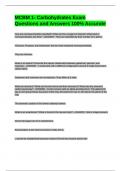Exam (elaborations)
MCBM 1- Carbohydrates Exam Questions and Answers 100% Accurate
- Module
- Institution
MCBM 1- Carbohydrates Exam Questions and Answers 100% AccurateMCBM 1- Carbohydrates Exam Questions and Answers 100% AccurateMCBM 1- Carbohydrates Exam Questions and Answers 100% AccurateMCBM 1- Carbohydrates Exam Questions and Answers 100% AccurateMCBM 1- Carbohydrates Exam Questions and Answers 10...
[Show more]



